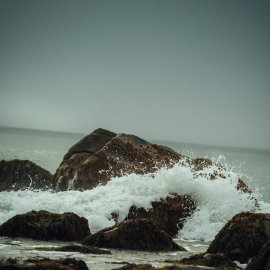RESCUE, part 8: Policy Applied
-
English
-
ListenPause
[intro music]
Welcome to World Ocean Radio…
I’m Peter Neill, Director of the World Ocean Observatory
Treaties are examples of policy applied. Whether or not derived by consensus, they are agreements that are established with purpose and obligation which are accepted by the signatories, administered and enforced by an established structure, and transformed from the theoretical to the real. There are a number of ocean treaties, based on conservation policy, that are successfully engaged in regulation and oversight that applies the policy intention specifically and successfully.
There are some compelling examples, first among them the Antarctic Treaty executed in 1959. According to a background briefing paper prepared by the British Antarctic Survey for all visitors to Antarctic: “…the Antarctic treaty has been proven the model for a successful international agreements. Twelve nations [Argentina, Australia, Belgium, Chile, France, Japan, New Zealand, Norway, South Africa, United Kingdom, United States and USSR] agreed that the vast area south of latitude 60 degrees south would be protected under the following fourteen articles that declared that Antarctica should be used exclusively for peaceful purposes. Military activities, such as the establishment of military bases or weapons testing, are specifically prohibited; that freedom to conduct scientific research, would continue; that international scientific cooperation including the exchange of research plans and personnel, and results of research, would be assured; that no matters of sovereignty or enlarged claims could be made; that prohibits nuclear explosions and the disposal of radioactive waste; that provides for inspection by observers, designated by any party, of ships, stations and equipment in Antarctica to ensure the observance of, and compliance with, the Treaty; that requires parties to give advance notice of their expeditions; that provides for the parties to meet periodically to discuss measures to further the objectives of the Treaty; and that puts in place a dispute settlement procedure and a mechanism by which the Treaty can be modified. Other nations have been permitted to join, to date there are 52 signatories and membership continues to grow. The Treaty parties remain firmly committed to a system that is still effective in protecting their essential Antarctic interests. Science is proceeding unhindered.”
Another example is the Sargasso Sea. In 2014, after a two-year negotiation, led by Bermuda,
governments [of the Azores, Bermuda, Monaco, UK and US, the British Virgin Islands, the Bahamas, Canada, the Cayman Islands, and the Dominican Republic,] signed The Hamilton Agreement, subscribing to a common vision that recognized that “the Sargasso Sea is an important open ocean ecosystem, the majority of which lies beyond national jurisdiction, which deserves recognition by the international community for its high ecological and biological significance, its cultural importance and its outstanding universal value…worthy of conservation for the benefit of present and future generations.”The Sargasso Sea is described as an “extraordinary open-ocean ecosystem bounded by currents circulating around the North Atlantic sub-tropical gyre and is unique for supporting the center of distribution and abundance for a community of continuously pelagic drift algae; it provides habitats, spawning areas, migration pathways and feeding grounds to a diverse assortment of flora and fauna, including endemic, endangered, and commercially important species; in particular, Sargassum, a holopelagic, thick seaweed, an unique concentration of golden drift algae that can aggregate to form extensive floating mats on the surface of the ocean”. It is a diverse, free-floating fecundity, that Dr. Sylvia Earle has called “the golden rainforest of the ocean.” It is, in effect, an ocean within the ocean, encompassed by major circulating currents that ebb and flow and shape its perimeter as a fluid, dynamic space. How do we design a structure to protect such a thing, how can it be governed, how to define and enforce conservation policies with best intention and effect?
The Sargasso Sea Commission is a group of seven individuals from government, science, and the private sector, representative of the participant nations, who, with a small secretariat, create the guidelines and projects that allow for the study and preservation of this amazing resource. It is as if a small group of neighbors got together to make the rules, to enable the studies, and quietly encourage and enforce best practices to uphold a regional “community’ vision. It is a modest demonstration of the best of ocean conservation, the affirmation of possibility made purposeful and real.
Antarctica and the Sargasso Sea are applications of RESCUE:
R for renewal; E for environment; S for society; C for collaboration; U for understanding; and E for engagement.
We will discuss these issues, and more, in future editions of World Ocean Radio.
World Ocean Radio is distributed by the Public Radio Exchange and the Pacifica Network, in collaboration with WERU-FM, Blue Hill, Maine. Find us wherever you listen to podcasts and at world ocean observatory dot org, where World Ocean Radio episodes are now searchable by theme. Find the RESCUE series by clicking on the SOLUTIONS banner.
[Outro music]
This week we continue the multi-part RESCUE series with a highlight of two policies--the Antarctic Treaty and the Hamilton Agreement for the Sargasso Sea--that are working to successfully engage parties and members and maintain oversight for ocean and ecosystem conservation. RESCUE as an acronym offers a plan for specific action and public participation: Renewal, Environment, Society, Collaboration, Understanding, and Engagement.
About World Ocean Radio
5-minute weekly insights dive into ocean science, advocacy and education hosted by Peter Neill, lifelong ocean advocate and maritime expert. Episodes offer perspectives on global ocean issues and viable solutions, and celebrate exemplary projects. Available for syndicated use at no cost by college and community radio stations worldwide.
Image
Photo by Tim Foster on Unsplash
@timberfoster
- Login to post comments



